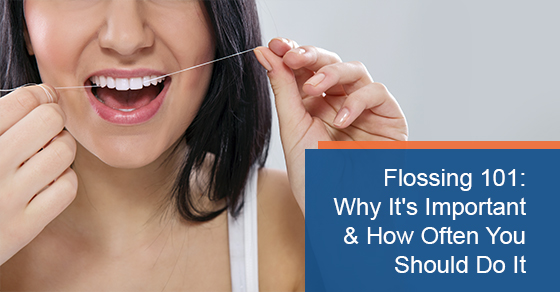We all know the cardinal rule of
good oral health: brush and floss regularly. But the reality is, knowledge and practice are two very different things. Just because we know these basics by heart doesn’t mean we follow them regularly.
Flossing, in particular, is tougher to follow because it requires cleaning between the teeth to remove plaque build-up. That’s a lot of
cleaning for a full set of teeth, on top of brushing at least twice a day. It’s no surprise, then, that a lot of people are guilty of skipping out on it until it’s too late. By then, the plaque build-up has already developed into a cavity and other worse dental problems.
When was the last time you flossed or booked professional teeth cleaning service? If you’re wondering why you need to get in the habit of flossing on top of regular brushing, and how often you actually need to do it, it’s a good time to revisit these basics:
Do I need to floss?
Many people who don’t floss say it’s because they already clean their teeth with regular brushing, and view flossing as just an extra but unnecessary precaution, something they don’t need to do because their teeth are healthy. But they’re wrong.
It also does not help that there was some confusing news about flossing. These claim that flossing is not essential to your daily oral hygiene, despite vouching for oral prophylaxis, professional teeth cleaning, and frequent brushing. There are also fewer studies about flossing, particularly those that confirm the importance of regular flossing just as much as brushing.
However, here’s where they are wrong: your toothbrush cannot effectively reach your entire mouth, especially between the teeth, which are not visible surfaces. It’s only with interdental cleaning, like flossing, that cavity-causing plaque build-up can be removed. Simply, flossing can remove debris lodged between teeth: something the bristles of a toothbrush can’t do. Even when you brush regularly but don’t floss, you are at higher risk of cavities, tooth decay, and gum disease.
How often should I floss?
We all know that we need to brush at least twice a day. Brushing cleans the visible surfaces of the teeth, but it’s flossing that cleans the hard-to-reach places between teeth, and along the gum line.
To prevent plaque build-up and gum disease, you need to floss daily, at least once a day. If you were rushing to brush your teeth after an earlier meal, flossing during your next brush allows you to remove the hard-to-reach plaque, bacteria and food particles.
So, aim to floss as much as you brush for increased protection against
cavities and gum disease. Flossing after every meal removes debris stuck between your teeth and prevents plaque build-up outright. There’s no such thing as too much flossing — unless you’re doing it incorrectly and applying so much pressure that it damages your teeth and gums.
How to Floss
While there’s no such thing as flossing too much, it’s important to do it correctly to remove debris effectively and prevent damage to your teeth and gums. It takes a bit of practice, but once you get in the habit of flossing, you’ll wonder why it hasn’t always been part of your
regular oral hygiene routine.
Here’s how to floss correctly in five easy steps:
- Break off a piece of floss about 18 inches long and wind most of the piece around the middle finger of one hand. Wind the remainder around the middle finger of your other hand, leaving a strand in between.
- Hold the floss between your index fingers and thumbs, then slide the strand between two teeth.
- Move the floss up and down. Make sure to reach the gum line, then curve it and gently slip it under the gum next to one tooth.
- Clean under the gum of the adjoining tooth. Move the floss up and down tightly against each tooth to clean between the teeth.
- Gently slide the floss out and unwind a fresh section to repeat the process and floss between all teeth.
When is the best time to floss?
Get in the habit of flossing by doing it when you brush your teeth. For best results, the Journal of Periodontology recommends flossing first then brushing to remove debris lodged between teeth, making it easier to brush them away. This also maintains the fluoride concentration on the tooth enamel after brushing.
I have difficulty flossing. Are there alternatives?
Flossing takes time and practice to master. But for some people, the challenge is with the material itself and wedging the floss between teeth. If you have trouble with traditional floss, try waxed floss which slips between teeth more easily. You can also try interdental cleaners, such as pre-threaded flossers and dental picks which are easier to grip at the handle.
If these don’t work, you can also look into tiny brushes that can reach better between teeth, as well as plaque removers and powered water flossers. However, note that even if water picks can remove debris and help reduce bacterial build-up below the gum line, they are not as effective at removing plaque compared to actual dental floss.
For best results, you can also ask your dentist about teeth cleaning services. While you floss every day at home, professional teeth cleaning reinforces your daily oral hygiene routine and helps ensure the prevention of cavities and gum disease. During your appointment, your dentist or dental hygienist can also recommend other types of interdental flossers based on your dental structure and existing oral conditions or appliances like braces that make it hard to floss on your own.
To learn more about flossing techniques and get started with teeth cleaning services in Toronto, call Bloor West Smiles Dental at 647-691-8363 or
contact us here.
Updated for 2022

Sorry, comments are closed for this post.